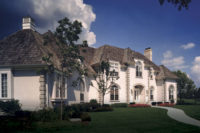Continuous Insulation Wall System With Stucco Finish Delivers Strong Performance
The Muny Faces of St. Louis.










As part of a $100 million capital campaign, The Muny opened its 101st season in June with a $33 million facelift highlighted by a new rotating stage, lights, LED screen, orchestra pit and other amenities to enhance the visitor experience. A welcome, but less visible element of renovating the country’s oldest and largest outdoor musical theater, are two mechanical rooms fitted with industrial fans and air ducts to cool guests during summer shows. A continuous insulation wall system, finished with QUIKRETE One Coat Fiberglass Reinforced Stucco (FRS) was used to give the mechanical rooms an attractive, durable exterior befitting The Muny.
Adapting to the Weather
Located in two architectural shell-shaped towers constructed of steel, concrete, concrete masonry units and drywall that frame each side of the stage, the well designed and constructed mechanical rooms were critical to the overall appearance and comfort of The Muny. “The mechanical rooms are home to our audience air distribution system, which provides gentle breezes theatre-wide on warm summer nights,” explains Sean Smith, director of operations for The Muny. Ironically, the mechanical rooms designed to cool The Muny audience were constructed under the cover of a heated tent.
“St. Louis experienced an unusually cold and harsh winter, which impacted the entire project including the wall system,” notes Josh Phillips, vice president with stucco installer Phillips Interior/Exterior Systems. “On the days when the temperatures didn’t fall below freezing, our crews worked long hours. It required tenting and heating the two mechanical rooms, as well as the area housing the stucco pump to get the job done on time. Having used stucco in the past, we were confident it would perform as needed, especially to move along the finishing process.”
Weight Concerns
Specified by H3 Hardy Collaboration Architecture, the CI wall system consists of fiberglass mat gypsum wall sheathing, vapor permeable fluid-applied membrane weather barrier, rigid board insulation extruded polystyrene foam (XPS) and metal lath covered with FRS. With nearly 15,000-square-feet of FRS pumped from a staging area and applied at 3/4 inch thick, any concerns about the weight of the system quickly disappeared.
“We haven’t done much with insulated stucco systems in the St. Louis market and the plasterers had some concerns about the weight of the stucco over 3-inch XPS board,” says Rick Moore, product manager for exterior claddings with the stucco supplier, Negwer Materials Inc. “Early on the plasterers realized the CI system was working just as designed and were very impressed with the results. This was a high-profile project on a really demanding schedule in very tight quarters, so the advantage of using pre-mixed scratch and brown coats proved significant for completing the work on time.”
Moore also confirmed that Phillips Interior/Exterior Systems found pump applying the FRS to work extremely well for the CI system application. As part of the process, the stucco was finished with a texture to complement the artistic circular vents on the exterior of the mechanical rooms. In addition to meeting required energy building codes, the CI wall system with stucco finish proved to be a resilient impact resistant alternative to an EIFS for renovating The Muny.
Enhancements for the Future
Tarlton Corp., a St. Louis-based general contracting and construction management firm, served as the construction manager for the stage and production improvements. “Tarlton has completed many projects over 20 years for The Muny, which gave us good familiarity with what they hold dear, and with the inner workings of this one-of-a-kind performance venue,” noted Cameron Denison, Tarlton senior project manager.
Offered Dennis Reagan, The Muny president and chief executive officer, “As we look toward the second century of The Muny, these improvements are designed to enhance the musical theater experience for St. Louisans and visitors and are vital to its future.”
Phillips agreed, “You take pride in working on a project that helps preserve the rich legacy of an institution like The Muny. It’s a historic cornerstone in St. Louis that dates back to the turn of the 20th Century and I’m confident this latest transformation will allow future generations to enjoy it into the 22nd Century.” W&C
Looking for a reprint of this article?
From high-res PDFs to custom plaques, order your copy today!










